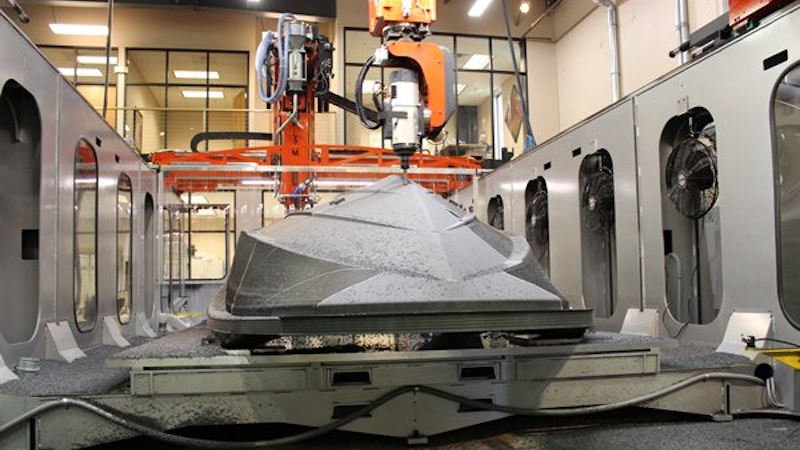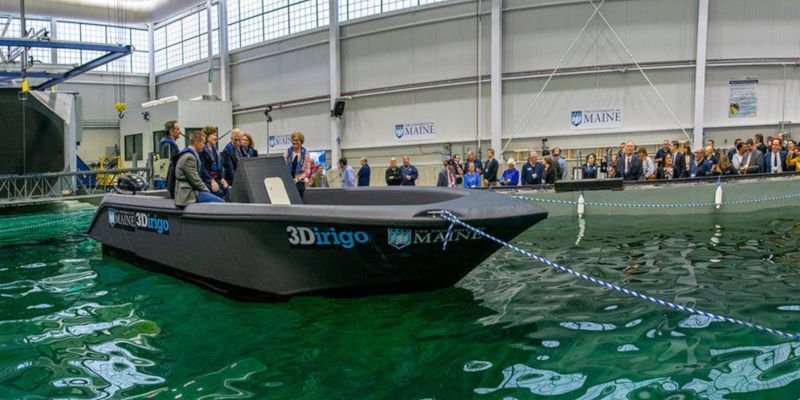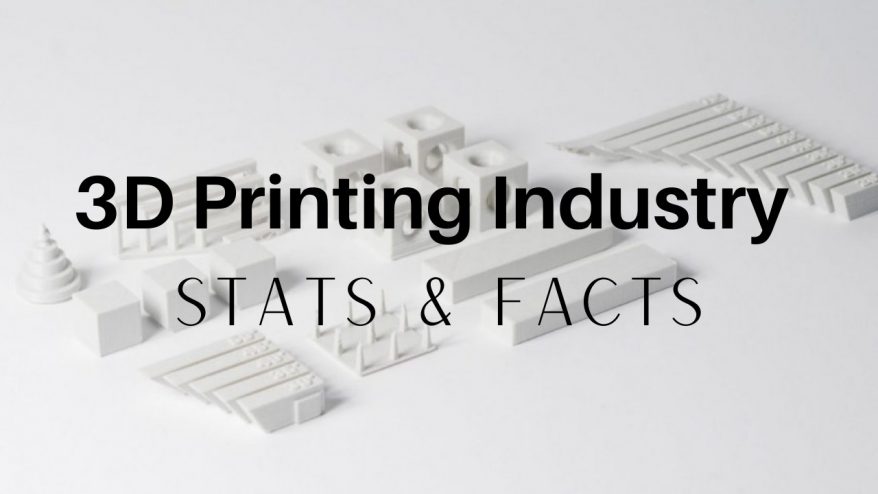3D printed boats have seen a lot of developments in recent years, and have yielded some impressive results, overall showing a lot of promise for exciting and environmentally friendly vessels.

In this guide I’ll be showing you some of my favorite examples of companies making huge waves in 3D printing boat technology, everything from upcoming luxury liners to customizable sloops made from recycled materials.
- Top 3D Printed Boats Projects
- 3Dirigo – The Largest 3D Printed Boat from the University of Maine
- Tanaruz Boats – Customized 3D Printed Boats
- Pegasus 88m – The Carbon-Neutral Superyacht
- Hydra – The World’s First 3D Printed Aquatic Drone
- Autonomous Ferry – 3D Printed Ferry For Paris
- Impacd Boats – Sustainable 3D Printed Sloops
- Solvit3D – 3D Printed Boat Parts
- Advantages of 3D Printing in Boats
Top 3D Printed Boats Projects
3Dirigo – The Largest 3D Printed Boat from the University of Maine
- Company: University of Maine
- Price: Not For Sale
- Where to Learn more: 3Dirigo and Guinness World Records Official Site
University of Maine Composites Center research team broke three Guinness World Records with 3Dirigo, the largest 3D printed boat to date, weighing 2.2 tonnes and measuring 7.62 meters.

Created in just 72 hours with a plastic-wood cellulose mix, this milestone was achieved using a 3D printer developed in partnership with Ingersoll Machine Tools. This wasn’t the only example of such a partnership, as the University of Maine’s Advanced Structures department has since worked in military equipment development in 2022.
Capable of additive and precise subtractive manufacturing, the printer can prototype for defense, civil, and infrastructural applications. With a capacity to print objects up to 100 ft long, 22ft wide, 10ft high, and a rate of 500 pounds per hour, UMaine has found itself a real game changer.
The same 3D printer drew the attention of the US Army Combat Capabilities Development Command for deployable shelter systems production, with the UMaine presenting a 3D printed army communication shelter alongside 3Dirigo.
Tanaruz Boats – Customized 3D Printed Boats
- Company: Tanaruz
- Price: $16,000+ (Price varies depending on model and customization options)
- Where to Buy: Tanaruz Boats
One of the biggest advantages of 3D printed boats is customization. Dutch start-up company Tanaruz offers fully personalizable 3D printed boats made to order via their app.
From this app you can select the model, shape, color, and even engine type to get exactly the boat you’d like using additive manufacturing to maximize efficiency and precision.
With the cost-cutting advantage of 3D printing, the Tanaruz team makes their boats very affordable for most customers without sacrificing quality. For just a €500 (~$556) deposit, you can reserve your dream 3D printed boat.
Pegasus 88m – The Carbon-Neutral Superyacht
- Designer: Jozef Forakis
- Price: Not Yet Released
- Where to Learn More: Pegasus 88m
The Pegasus 88m is a 3D printed ‘superyacht’ that even in 2023 only really exists on paper, but is still well worth talking about. Designed as a completely carbon neutral 3D printed luxury boat, it was conceived with nature a the forefront of designer Jozef Forakis’ mind.
Solar powered panels power electrolyzers that convert seawater into hydrogen, which is then stored in long-term tanks for later fueling. This means the Pegasus 88m can harness the power of the ocean for theoretically unlimited power, removing the need for fossil fuels entirely.
The Pegasus 88m is designed to look like a cloud as it floats on the water. Using a clever mirrored design, the idea is for the frame to reflect the ocean and great the illusion of invisibility.
While still a work-in-progress, we recommend keeping an eye on this exciting, albeit likely unaffordable, 3D printed boat project.
Hydra – The World’s First 3D Printed Aquatic Drone
- Company: AI Seer Marine
- Price: Not For Sale
- Learn More: Naval News
UAE company AI Seer Marine specializes in unmanned boats, and they unveiled the final version of their 3D printed vessel, Hydra, in 2023.
The 5 meter (~16’ 5’’) Hydra is effectively a proof-of-concept that additive manufacturing can play a key role in boat construction. AI Seer Marine uses the lightweight nature of 3D printed frames and parts to enhance speed and efficiency as well as cutting costs along the way.
The project has been underway for some time, and only recently been unveiled as close to finished. You can see the first active trials of the Hydra’s prototype below.
Those of you familiar with boats will recognize the Hydra employs a ‘stealth’ shape, intended for use in naval ISR (intelligence, surveillance, and reconnaissance) missions. This means that it likely won’t be available for sale, but it’s still a cool project to keep an eye on.
Autonomous Ferry – 3D Printed Ferry For Paris
- Companies: Roboat, Holland Shipyard, and Sequana Développement
- Price: N/A
- Learn More: Holland Shipyard
The collaborative effort of innovation partners Roboat, Holland Shipyard, and Sequana Développement has born this concept for the autonomous ferry designed to carry tourists and athletes along the Seine river in Paris in preparation for the 2024 olympics.
The model builds on previous Roboat builds of self-sailing and docking passenger vessels in Amsterdam, as you can see in the video below.
Offering visitors and locals alike a unique and futuristic experience in small-scale aquatic travel, the three companies hope this ferry will showcase enough features to be a great step in the future of 3D printed autonomous boats, possibly even replacing bridges.
The companies are being quite secretive about their 3D printed ferry so far, but Olympics-goers are looking forward to experiencing the boat for themselves. And at a planned size of 9 x 3.9m (29.5 x 12.7′), it promises to be the world’s largest 3D printed autonomous ferry ever made.
Impacd Boats – Sustainable 3D Printed Sloops
- Company: Impacd Boats
- Price: $40,000+
- Where to Buy: Impacd Boats
3D printed boats don’t have to be big and flashy, they can also be simple but effective crafts to handle small-scale sailing. Impacd Boats offers customizable 3D printed sloops as comfortable and easy-to-ride boats for any lazy river fan to buy and enjoy.
The main mission is tackling carbon emissions and making a positive impact on environmental health. Their boats are 3D printed using recycled waste material, and even the decorative items included with their models are from sustainable origins.
Impacd Boats took inspiration from data taken from TU Deflt research into sustainability in aquatic travel, and developed a greener, more environmentally friendly construction process using additive manufacturing. Each boat even features an energy-efficient motor that is as silent as they are safe.
They only have two models available at the moment, but are working on the technology to release different kinds of sloop at affordable prices for anyone who wants to discover how to sail guilt-free.
Solvit3D – 3D Printed Boat Parts
- Designers: Alexander and Roman Schmidt
- Price: $1 – $16,694.85
- Where to Buy: Solvit3D
3D printed boats are exciting, but 3D printed boat parts are making just as much of a difference. Solvit3D specializes in 3D printed objects like boat parts and decorations, offering over 60 different examples from light fixtures to compass covers and even custom switch panels.

Brothers Alexander and Roman founded Solvit3D after discovering additive manufacturing’s ability to create complex geometrical shapes with speed and ease. The parts are light and highly customizable for any taste or any boat.
While they don’t 3D print entire boats, Solvit3D should be bookmarked by any sailing enthusiast for practical replacement parts and aesthetic upgrades at very reasonable prices.
Advantages of 3D Printing in Boats
3D printed boats have several key advantages including less waste, lighter weight, quicker and cheaper repairs, and lower carbon footprint.
Reduced Waste
Traditional subtractive boat production, such as CNC milling, results in a lot more waste than 3D printing, making additive manufacturing a more cost-effective and sustainable process.

It’s also worth mentioning that some woods used in boat production are unsustainably, and sometimes even illegally, sourced, further adding to the need for alternative materials and manufacturing methods.
Research in the sustainability measures in boatbuilding carried out in 2021 shows some frankly alarming statistics. Only 55% of companies have a sustainable sourcing policy for their building materials, while 40% claim to not have the budget to research or implement more environmentally friendly construction methods.

Lighter and Better Balanced Boats
Additive manufacturing yields boats that are lighter, faster, and better balanced due to the use of 10-30% infill. Projects like Rammses predict 3D printed boat propellers weighing 40% less than conventional ones. By 2030, lighter titanium could replace steel in yacht production.
Efficient Repairs
3D printing can expedite and reduce the cost of repairs by producing spare parts on-site, a strategy already utilized in the automotive industry.
Lower Carbon Emissions
3D printed boats are more environmentally friendly due to research into lighter, more efficient materials like aluminum alloys for propellers, which can be printed anywhere to minimize transportation.

This innovation is crucial for the maritime sector striving to reduce carbon emissions and waste material through CNC machining. Searious Business, a Dutch association fighting against plastic pollution, even plans to print a 3D boat from plastic waste like Impacd Boats are.
Future of 3D Printed Boats
The boat design industry’s future includes a growing shift to 3D printing, resulting in cheaper, better-performing, and more eco-friendly vessels. The technology will revolutionize the industry by 2030, according to expert Gregory Marshall, with potential applications ranging from self-driving canal taxis to futuristic super yachts, as seen in the innovative 3Dirigo project.















